#1684-1692 - Southwest Spider Orchids
#1684 - Caladenia procera - Carbunup King Spider Orchid
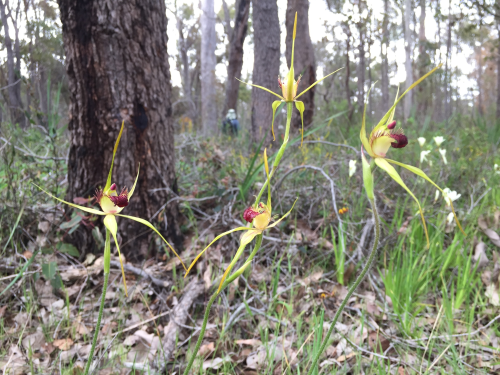

Happily, travel restrictions inside Western Australia were lifted soon enough that the WA Naturalists Club weekend trip to the Yallingup area could still go ahead. So we got to see a really nice selection of species, such as this Carbunup King, one of the tallest and largest Spider Orchids.
Caladenia procera is critically endangered, currently known from a linear range of less than 15 km to the south-west of Busselton, where it grows in Jarrah, Marri and Peppermint woodland on alluvial sandy-clay loam flats with Anigozanthos manglesii, but also from a disjunct occurrence some 70 km north near Kemerton. The geodata for the species on iNaturalist is deliberately obscured, to protect them from disturbance, but since they were doing remarkably well in the drain beside the road, and along the well worn footpaths in this particular tiny area of remnant woodland, they would seem to be tolerant of minor disturbance. Having most of the countryside clear-cut for paddocks, and the rest burnt at the wrong time of year, is not minor disturbance.
#1685 - Caladenia ferruginea - Rusty Spider Orchid
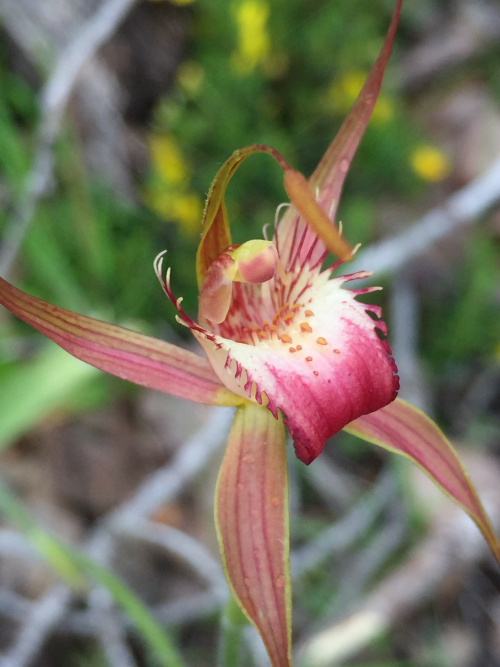
A much less endangered orchid than the Carbunup King, but only because there are more areas of surviving bushland between Perth and Albany, and it grows in a wider range of habitat, ranging from well-drained soil in woodlands to swamps which are flooded in winter
#1686 - Caladenia paludosa - Swamp Spider Orchid
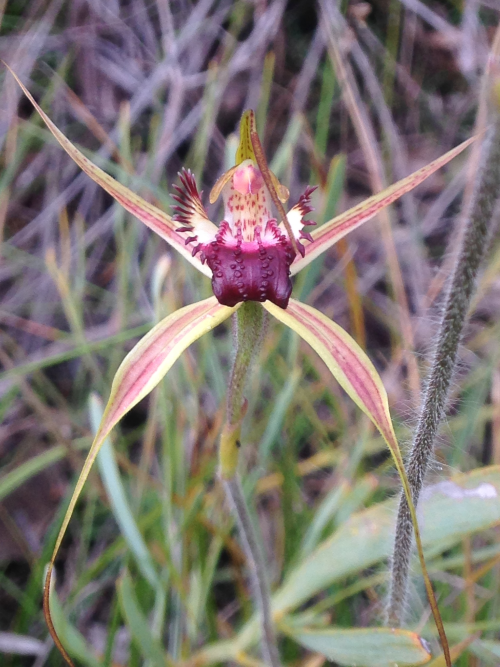
This one was in the Ambergate Reserve, which fits since the species is only found in dense scrub that is swampy in winter. Another SW endemic, growing over a wider area between Gingin and Gracetown, but flowering late in the season for Spider Orchids.
#1687 - Caladenia applanata - Broad-Lipped Spider Orchid
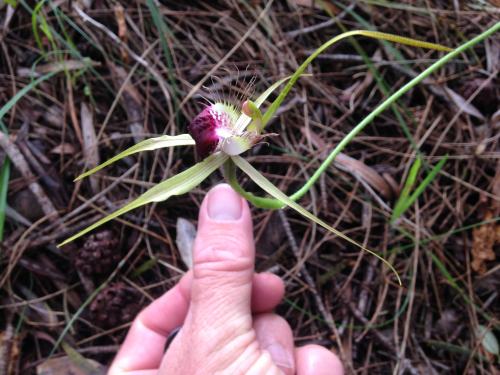
Another SW endemic, only found along two sections of coastal forest. First described in 2001, as two subspecies.
Yallingup, behind the old town hall.
#1688 - Caladenia viridescens -Dunsborough Spider Orchid

Another SW endemic, first described in 2001 by Stephen Hopper and Andrew Phillip Brown from a specimen collected at Cape Naturaliste. The specific epithet viridescens refers to the pale green colour of the flowers.
It’s only known from a few locations between Yallingup and Busselton in the Jarrah Forest biogeographic region, where it grows in shrubby woodland - in this case in a reserve within Dunsborough town limits. It’s classified as either threatened or endangered, with the main threats to the species being weed invasion and grazing and digging by mammals including rabbits, kangaroos, bandicoots and livestock.
#1689 - Caladenia nivalis - Exotic Spider Orchid
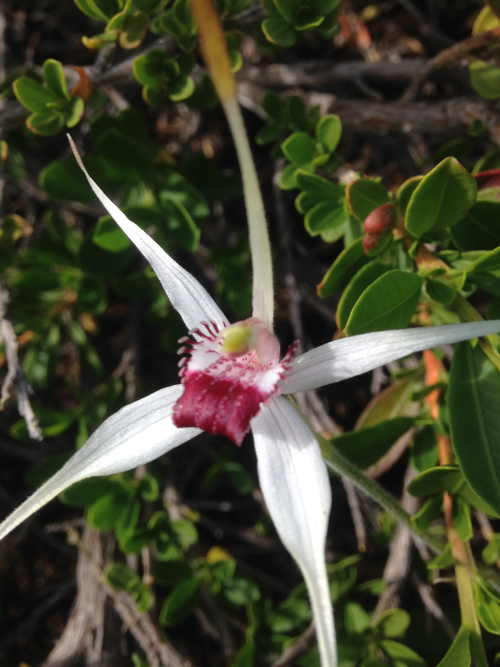
AKA Crystalline Spider Orchid. Another species first described in 2001 by Stephen Hopper and Andrew Phillip Brown
Only found in a narrow coastal strip in and around Leeuwin-Naturaliste National Park, but not considered threatened. Found in peppermint woodland, coastal heath and in granite crevices, within 100m of the shoreline. In this case in a granite crevice among coastal heath, overlooking Smiths Beach, Yallingup.
#1690 - Caladenia longicauda subsp. clivicola - Hill’s White Spider Orchid
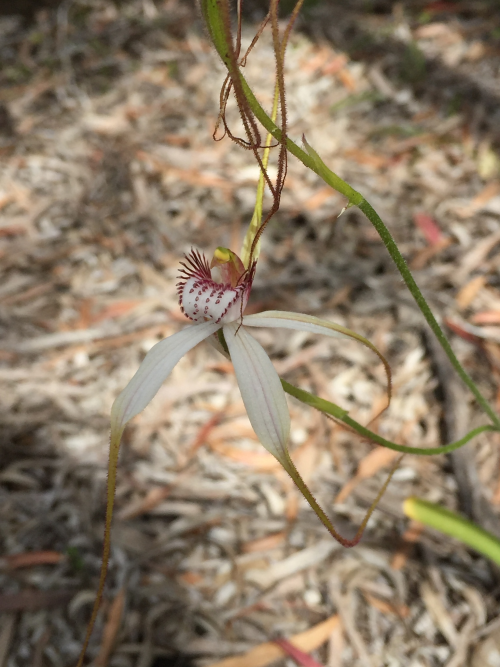
AKA Darling Scarp white spider orchid, or hills white spider orchid. There are about 180 species of Caladenia, and 140 here in the southwest corner of Australia, but this is one of the twelve subspeces split off Caladenia longicauda In 2001. The subspecies name is a derived from Latin clivus meaning “hillside" and -cola meaning “dweller”, referring to the sloping hills of the Darling Scarp where this subspecies was discovered.
This species occurs mainly on the Darling Scarp near Harvey but also near Dunsborough, nowhere near the ecarpment, in the Jarrah Forest and Swan Coastal Plain biogeographic regions. It grows in forest and shrubland near granite outcrops.
This one was growing in mixed woodland in laterite soil and granite above Meelup Beach, near Dunsborough, one of the few places in Western Australia where you can see the moon rising over the sea at certain times of the year, thanks to the bend in the cape. In fact the name means ‘Place of the moon rising’ in the language of Wadandi group of Nyungar people, who regarded it and continue to regard it it as an important location and calender event.
#1691 - Caladenia attingens - Forest Mantis-Orchid

Most of the other spider orchids we saw on this trip are were only found in very small areas, but we saw this species in three different places, including growing in the gardens outside the front door of the holiday house we rented.
It’s widespread between Perth and Israelite Bay, and the three subspecies prefer different soils and habitat types.
#1692 - Caladenia gemmata -Blue China Orchid
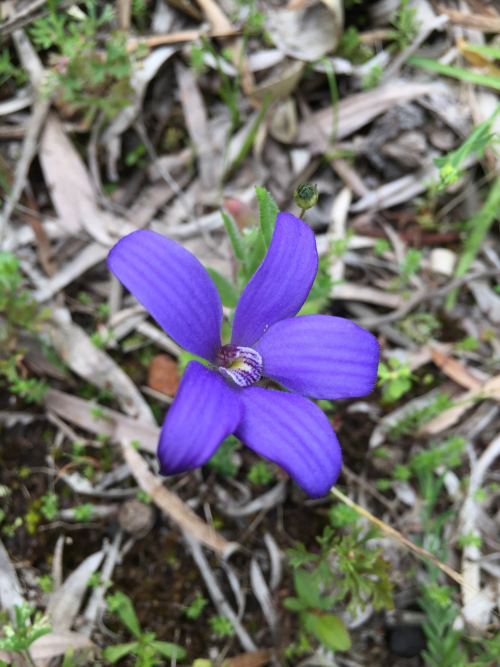
Another Caladenia, but sufficiently different in appearance to the bulk of the others that for a while it was Cyanicula gemmata, until molecular work in 2015 put it back in Caladenia. It was also called Pentisea gemmata, at one point.
It has a small, oval leaf and one to three intensely blue or mauve flowers. It is the most widespread and common West Australian china orchid, growing over much of the SW corner, and sometimes appears in large numbers after summer fires. This one was growing above the point at Meelup Beach near Dunsborough.